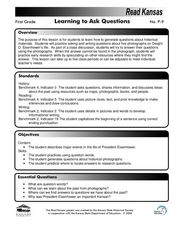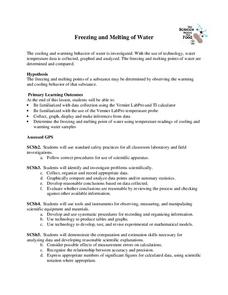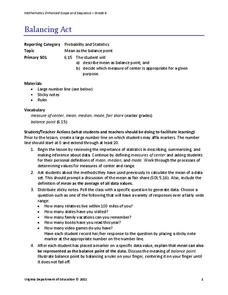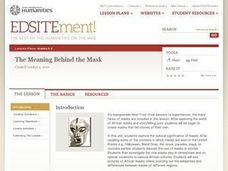National Endowment for the Humanities
Faulkner's As I Lay Dying: Burying Addie's Voice
Learners explore the use of voice and title in William Faulkner's, "As I Lay Dying". They identify and discuss the use of image, symbols and narrative voice in the story.
National Endowment for the Humanities
Hamlet and the Elizabethan Revenge Ethic in Text and Film
Young scholars research the social context of Elizabethan England for Shakespeare's "Hamlet". They identify cultural influences on the play focusing on the theme of revenge and then analyze and compare film interpretations of the play.
Curated OER
Move It!!!
Students explore motion by observing the movement of people and duplicating those movements. They compare and contrast various kinds of movements and identify different types of movements in pictures. They build an object that can be...
Pyro Innovations
Get into Shape
Shapes are so fun! Little ones explore, identify, and create shapes using tangrams or pattern blocks. The activity is intended to stimulate critical thinking while engaging learners through play and shape identification. Each child will...
Curated OER
Learning to Ask Questions
First graders analyze historical materials and create questions about Dwight D. Eisenhower. In this question writing lesson, 1st graders ask and answer questions about the life of Eisenhower. Students write about photographs they view.
Curated OER
I Served in the American Civil War
Students research soldier's lives in the American Civil War. They create a video about a soldier's life
Curated OER
De-Mystifying Poetry: Understanding Narrative Poetry
Tenth graders explore narrative poetry. They analyze sections of a poem and present to groups. They compose their own narrative poems using pictures as prompts. They exchange their poems and analyze their classmate's poem.
Virginia Department of Education
Weather Patterns and Seasonal Changes
Get your class outside to observe their surroundings with a lesson plan highlighting weather patterns and seasonal changes. First, learners take a weather walk to survey how the weather affects animals, people, plants, and trees during...
University of Georgia
Freezing and Melting of Water
Examine the behavior of energy as water freezes and melts. An engaging activity provides a hands-on experience to learners. Collaborative groups collect data and analyze the graphs of the temperature of water as it freezes and then...
Curated OER
Turning the Tide in the Pacific, 1941-1943
Students explore the overall strategies pursued by the Japanese and the Allies in the initial months of World War II. What each side hoped to accomplish what what actually happened forms the basis of a comparison made in this lesson.
Curated OER
Ending the War, 1783
Students investigate how successful they were in obtaining their goals in the Revolutionary War. The peace feelers of 1775 are examined and the reasons for the British rejection of them explored. the main provisions of the Treaty of...
Curated OER
Friar Margil & The Spanish Missions
Students explore the life of Friar Margil de Jesus as well as other Spanish friars. They research Friar Margil and write a paragraph explaining why Spanish friars came to Texas. In groups, students create a PowerPoint presentation...
Austin Independent School District
Visual Discovery Note Taking Sheets
Step into history and step out with a new understanding of events. These strategies bring a new level of understanding of key events by asking viewers to engage in and respond to projected images. Complete directions for the activity, a...
Habitat Conservation Trust Foundation
Greenhouse Gas Game
You will need to gather a number of tokens, bags, and other various game components in order to incorporate this activity into your curriculum. Different tokens represent carbon dioxide, methane, and nitrous oxide. Printable 8.5"x11"...
Virginia Department of Education
Balancing Act
How many different interpretations of the mean are there? Scholars place numbers on a number line and determine the mean. They interpret the mean as the average value and as the balance point.
Biz Kids
Understanding Business Ethics
After screening an episode by BizKids, scholars show what they know about business vocabulary, then take part in grand conversations about role models and ethical dilemmas.
Curated OER
Surrender at Yorktown
Eighth graders examine the start of the American Revolution. In this American History lesson, 8th graders analyze primary sources. Students prepare a narration of events leading up to the revolution.
Curated OER
Using Newsprint as a UV Detector
Students investigate the effects of UV radiation. In this earth science lesson, students explain how the time of day relate to UV abundance on Earth. They determine if weather affects the amount of UV that Earth receives.
Curated OER
Alcohol and Pregnancy Don't Mix!
Seventh graders learn about John Kellerman, a youngster who was born with Fetal Alcohol Syndrome. They learn how alcohol and pregnancy doesn't mix.
Curated OER
Protective Design
Over 3 or 4 class periods your young designers will create a wearable garment that provides some sort of protection from a danger in everyday life. In this fashion design lesson, young scholars investigate fear in our society and...
Curated OER
“Pardon This Interruption-Columbus Has Landed!!!”
Students research, design, rehearse, record, and present a 60 second Public Service Announcement, based on Columbus' arrival in the America. The students, working in groups, utilize the design process in creating their PSA. This lesson...
Curated OER
Uniform Design
Learners investigate the military by examining their uniforms. In this design lesson, students analyze the military uniforms from different locations and time periods. Learners create new ideas for current military uniforms.
Curated OER
The Meaning Behind the Mask
Students explore the world of African masks and storytelling. They create masks that tell stories of their own.
Curated OER
Theobroma - Food of the Gods
Students discuss the history of cacao and its use in the production of chocolate. They analyze actual cacao pods and record their observations. Finally they create a five minute contour drawing of the cacao pod and seeds.

























